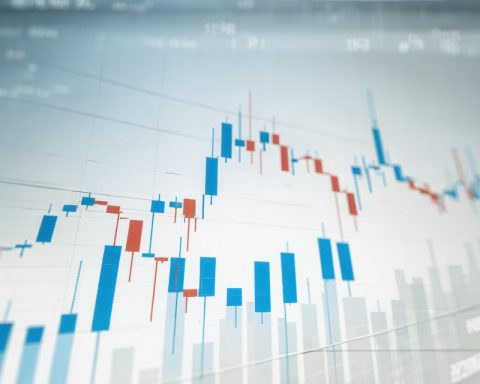- Retail investors have shifted focus from Nvidia, once celebrated for its AI-centric GPUs, to Tesla, a major player in electric vehicles and energy solutions.
- Nvidia’s chips, crucial for AI model training, face increasing competition as clients develop in-house alternatives, affecting its market dominance.
- Tesla captivates investors with its ambitious vision, including self-driving cars and robots, despite Elon Musk’s history of overpromising.
- Challenges persist for Tesla, with mounting competition in the EV market prompting frequent pricing strategy revisions to maintain margins.
- The stock market narrative underscores the blend of storytelling and financial analysis, emphasizing cautious optimism against market exuberance.
Peering into the busy corridors of Wall Street reveals a curious narrative unfolding: a seismic shift in the stock landscape among retail investors. Once dominated by the futuristic allure of artificial intelligence — the proverbial belle of the ball — the tech-savvy behemoth Nvidia briefly dazzled retail investors before stepping aside for Tesla, the electric vehicle juggernaut.
A frenzy greeted Nvidia’s majestic ascent. Their graphics processing units (GPUs), specifically the Hopper and Blackwell architectures, captivated the collective imaginations of AI enthusiasts and day traders alike. These chips, the cerebral cortex of modern data centers, execute lightning-fast computations and power the training of sophisticated models. Yet, despite the feverish zeal, signs began to appear that Nvidia might be merely the latest protagonist in the boom-bust cycles of technological revolutions.
History, an unyielding teacher, reveals that every transformative innovation enters a bubble of heightened expectations before reality tempers its progress. Nvidia’s chips, for all their prowess, faced mounting competition while some of their top clients began creating AI chips in-house, offering a cost-effective alternative that threatened to erode Nvidia’s market dominance and lauded gross margins.
Enter Tesla, sweeping back onto the stage as the darling of Robinhood’s retail cohort, buoyed by ambitions as vast as the horizon they chase. This electric titan enchants with promises of self-sustaining glory — a vision pioneered not only by their propulsion in electric vehicles but also by venturing into energy solutions. Analysts marvel at the potential of Tesla’s energy segment, with its promise of resilience across various economic weathers, presenting a lucrative sideline to the automotive enterprise.
Behind this magnetic dreamscape stands the controversial figure of Elon Musk. His aura, ethereal yet grounded in his promises of robotaxis and humanoid robots, entices many. Musk envisions a world where robotic chauffeurs roam free by 2025 and Tesla’s Optimus robot conquers daily chores, a market of staggering proportions. These forecasts see Tesla’s shares echoing towards the stars, with some projecting a valuation of $8.37 trillion by 2029, a figure that sparks debates on its plausibility.
Yet, behind the curtain of charisma lies the stark reality: Musk’s storied history of over-promise often overshadows the under-deliverances. Recall, if you will, the assertion of one million robotaxis by 2020, a vision pendent as we edge into mid-decade. Tesla’s penetration beyond Level 2 driving autonomy remains elusive, overshadowing Musk’s annual assurances of a breakthrough.
Moreover, the fervor over Tesla’s early triumphs in the EV arena faces a counterpoint. Rising competition has nudged Tesla to re-evaluate its pricing strategy multiple times, attempting to stave off the specter of bulging inventories and dwindling margins. Such adjustments, while strategic, highlight the pressures intrinsic to their market leader status.
This interplay of tech optimism and electric ambition encapsulates a broader truth about the stock market: it’s as much about storytelling as it is spreadsheets. Thus, this saga of retail investors, from Nvidia’s AI allure to Tesla’s electric dreams, serves as a potent reminder. Beware the temptations of unchecked exuberance, and heed the silent counsel of balance sheets and competitive landscapes. For in them lie the seeds of enduring investment wisdom.
Are Retail Investors Shifting Focus from AI to EVs? The Tesla and Nvidia Phenomenon
Unpacking the Retail Investment Shift: Nvidia to Tesla
The bustling corridors of Wall Street are witnessing a noteworthy transition among retail investors. Once captivated by Nvidia’s advances in artificial intelligence, these investors are now gravitating toward Tesla, the electric vehicle powerhouse. This change of heart is influenced by several pivotal factors in the market landscape.
Nvidia: The Chip Giant
Nvidia’s strength lies in its graphics processing units (GPUs), which have become vital in AI and data centers. The company’s Hopper and Blackwell architectures were well-received, offering advanced processing power that captivated AI enthusiasts. However, the competitive landscape is evolving:
1. Increased Competition: Major tech companies are developing in-house AI chips, thereby challenging Nvidia’s market position. For example, Google and Amazon have started creating AI chips tailored to their needs.
2. Boom-Bust Cycle: Nvidia’s rapid rise spurred speculation about a potential bubble. Historically, every tech revolution experiences a phase of exuberance before stabilizing.
3. Margin Pressure: As competition reduces Nvidia’s pricing power, maintaining high gross margins becomes challenging.
For more insights on AI trends, visit Nvidia.
Tesla’s Meteoric Rise
Tesla’s allure extends beyond electric vehicles (EVs), capturing the market’s attention with its energy solutions division:
1. Expanding Horizons: Tesla’s energy segment, focused on products like the Powerwall and Solar Roof, provides a cushion against fluctuations in the automotive market.
2. Visionary Leadership: Elon Musk’s ambitious plans for robotaxis and humanoid robots, despite their delayed timelines, continue to fuel investor optimism. His predictions see Tesla’s market valuation soaring to $8.37 trillion by 2029, sparking both excitement and skepticism.
3. Market Dynamics: The EV market’s competitive landscape forces Tesla to frequently adjust its pricing strategy to maintain its lead—mirroring pressures faced by other leaders in nascent industries.
For insights into EV technology and sustainability, explore Tesla.
Real-World Use Cases and Market Trends
1. Real-World Applications: Nvidia GPUs are being used in everything from autonomous vehicles to intricate machine-learning tasks, making them indispensable in several sectors.
2. Tesla’s Energy Initiatives: Tesla’s energy solutions are gaining traction in markets burdened by unreliable grid infrastructure, offering sustainable energy sources.
3. Future Trends:
– AI Sector: Expected to grow as AI technologies become integrated into everyday applications.
– EV Market: With governments pushing for reduced carbon emissions, the EV industry is poised for expansion.
Pressing Questions Answered
– Is Tesla Really a Safer Bet Than Nvidia?
While both companies are leaders in their fields, Tesla’s diversified business model offers a buffer against volatility, whereas Nvidia faces sector-specific challenges.
– What Should Investors Consider When Choosing Between Tesla and Nvidia?
Investors should weigh market trends, competitive pressures, and historical performance, while keeping an eye on future innovation trajectories.
– Are AI Chips a Risk for Nvidia?
The rise of in-house AI chip development by big tech companies does pose risks, but Nvidia’s innovation in other areas, like gaming and autonomous vehicles, may sustain its growth.
Actionable Investment Recommendations
1. Diversification: Avoid putting all your eggs in one basket—invest in a balanced portfolio mixing tech with other sectors.
2. Stay Informed: Engage with emerging market trends and adjust investments according to shifting landscapes.
3. Evaluate Fundamentals: Beyond storytelling, analyze financial statements and track company milestones against promised goals.
This dynamic narrative of Nvidia and Tesla captures the essence of stock market investment: a balance of innovation with grounded predictions. For more on real-time market shifts, visit Nasdaq.










